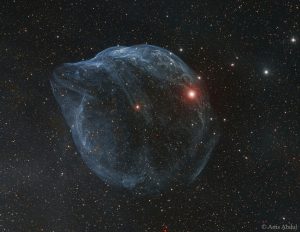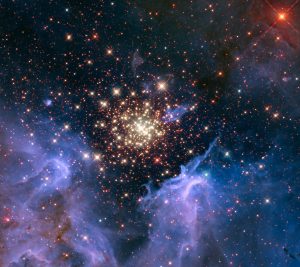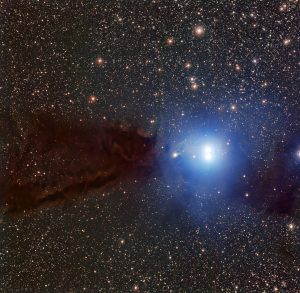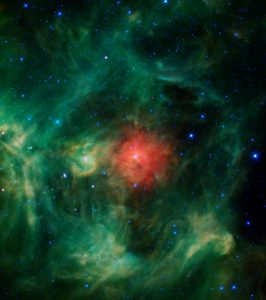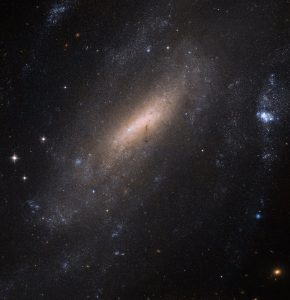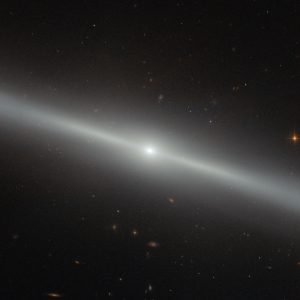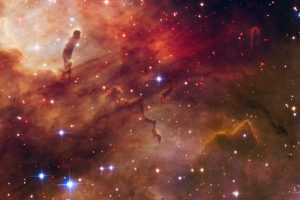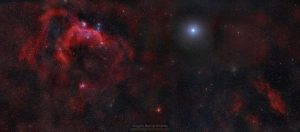Immagini
Sharpless 308: Una Bolla Stellare
Questa spettacolare bolla cosmica, soffiata da venti veloci emessi da una calda stella massiccia, è davvero enorme. Catalogata come Sharpless 2-308, si trova a circa 5.200 anni luce di distanza in direzione della costellazione del Cane Maggiore e abbraccia una regione in cielo poco piu grande di una Luna piena. Questo corrisponde ad un diametro di 60 anni luce alla sua distanza stimata. Continua a leggere
Scintillio di Stelle
Una giovane, scintillante collezione di stelle si presenta come uno spettacolo celeste di fuochi d’artificio. L’ammasso è circondato da nubi di gas e polveri interstellari, la materia prima per la formazione di nuove stelle. La nebulosa, che si trova a 20.000 anni luce di distanza nella costellazione della Carena, contiene un ammasso centrale di stelle ardenti e massicce, chiamato NGC 3603. Continua a leggere
Luce dall’oscurità
Questa immagine fiabesca, ripresa dal telescopio dell’MPG/ESO a La Silla, mostra una nube oscura in cui stanno nascendo nuove stelle insieme ad un gruppo di astri splendenti già emersi dalle polveri in cui erano avvolti. Continua a leggere
Una Ghirlanda in Cielo
In perfetto spirito natalizio questa spettacolare nebulosa ripresa dal telescopio WISE della NASA ha l’aspetto allegro ed elegante di una festosa ghirlanda, ornata di un bel nastro rosso, sempreverde e lucine d’argento. Il nome ufficiale è Barnard 3 o IRAS G159.6-18.5, ma è stata soprannominata in modo appropriato, Nebulosa Ghirlanda. Nubi come questa sono nursery stellari, regioni in cui nascono nuove stelle. Continua a leggere
La Galassia Ruota di Carro
A circa 500 milioni di anni luce di distanza nella costellazione dello Scultore, la forma della Galassia Ruota di Carro (Cartwheel Galaxy) è il risultato di una collisione galattica violenta. Una galassia più piccola è passata attraverso il disco di una grande galassia e ha prodotto onde d’urto che hanno travolto gas e polveri, in modo simile alle increspature prodotte quando un sasso cade in un lago. Lo scontro titanico ha innescato nella regione intensi fenomeni di formazione stellare. Continua a leggere
La Nebulosa Crescente
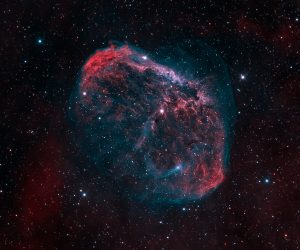 La Nebulosa Crescente, NGC 6888, è una straordinaria bolla cosmica ampia circa 25 anni luce, soffiata dai venti della brillante stella massiccia centrale. Continua a leggere
La Nebulosa Crescente, NGC 6888, è una straordinaria bolla cosmica ampia circa 25 anni luce, soffiata dai venti della brillante stella massiccia centrale. Continua a leggere
Uno sguardo ravvicinato a IC 5201
Nel 1900, utilizzando un telescopio all’Osservatorio di Cape Town in Sudafrica, l’astronomo Joseph Lunt ha individuato nella costellazione meridionale della Gru questo oggetto affascinante: una galassia a spirale barrata che ora si chiama IC 5201. Continua a leggere
NGC 4762: Una Scia Luminosa in Cielo
Questa straordinaria immagine del telescopio Hubble immortala una sorprendente galassia visibile di taglio, NGC 4762, tanto che appare simile ad una scia luminosa che percorre un silenzioso cammino nelle profondità del cosmo. Continua a leggere
Una Nidiata di Stelle Bambine
Questa splendida ripresa del telescopio Hubble mette in evidenza una parte delle nubi che circondano la famosa immagine dell’ammasso Westerlund 2, che contiene alcune delle stelle più calde, luminose e massicce conosciute, nella costellazione della Carena. Gli astri brillanti riversano torrenti di luce ultravioletta e intensi venti di particelle cariche che spazzano e scavano l’avvolgente nube di idrogeno gassoso. Continua a leggere
Sirio e il Gabbiano
Questa ampia, spettacolare immagine si estende in cielo per quasi 20 gradi. La regione interessata è ricca di nebulosità e si trova vicino al confine della superbolla di Orione-Eridano, densa di gusci di gas e polveri incastonati nelle nubi molecolari vicino al piano della Via Lattea. Continua a leggere
